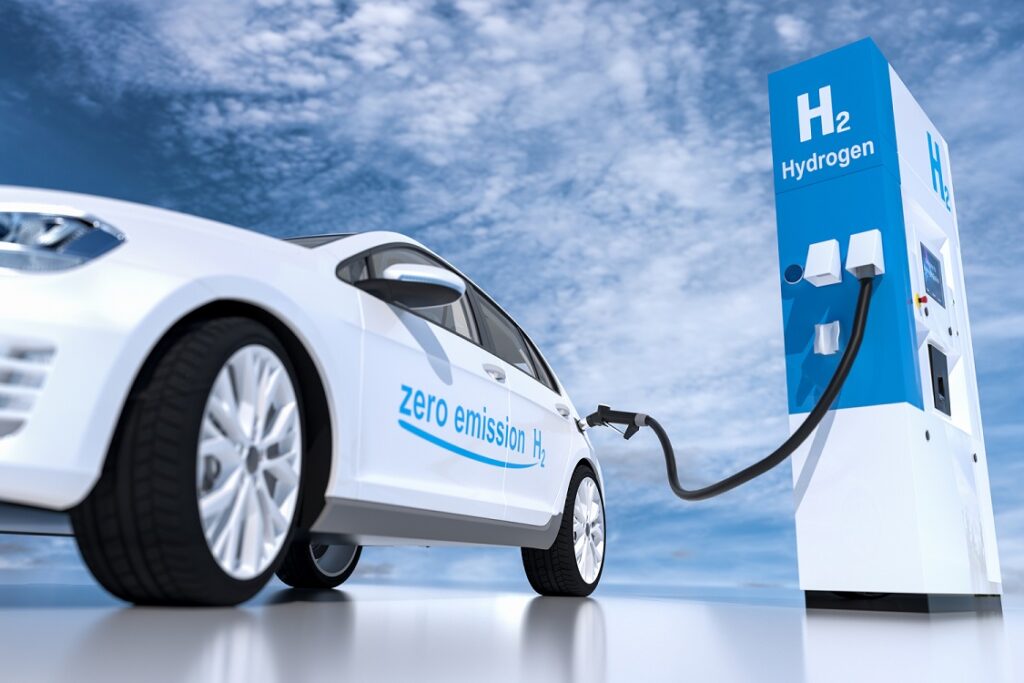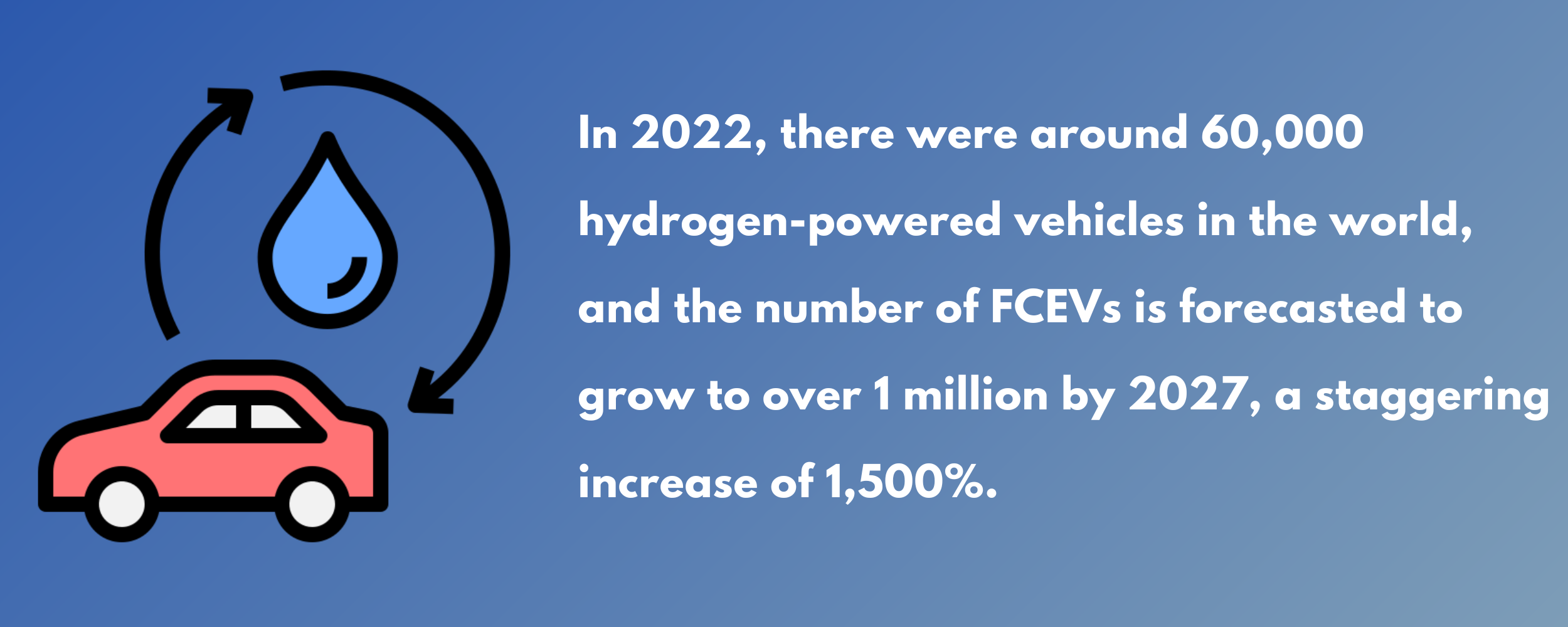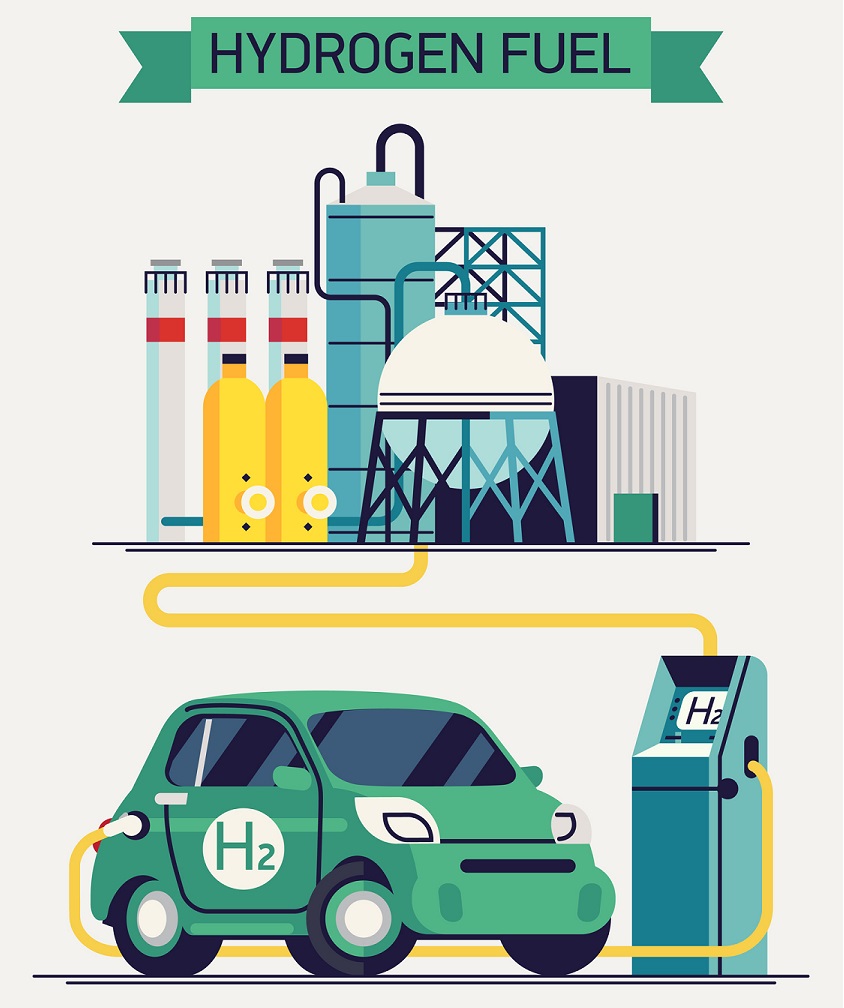Hydrogen is the most common chemical element on the planet, accounting for 75% of all natural matter. It exists as a compound with other elements, predominantly with oxygen in the form of water (H2O). Its abundance, together with its properties as an energy carrier, means that it has great potential as an alternative source of fuel. In the transportation sector, which contributes to 27% of all greenhouse gas emissions in the U.S., car manufacturers are harnessing the energy stored in hydrogen to create zero-emission cars.

What Is A Hydrogen Car?
Hydrogen cars, also known as fuel cell electric vehicles (FCEVs), are powered by a chemical reaction between hydrogen and oxygen which generates electricity. Unlike other electric vehicles which draw energy from a battery, hydrogen cars carry a fuel tank of hydrogen which is then converted into electricity by a fuel cell. No greenhouse gas emissions or other pollutants are produced in the process, with only water vapor and heat emitted from the tailpipe as byproducts. For this reason, hydrogen cars are considered to be one of the cleanest modes of transportation.
Now we know what FCEVs are, here are 10 key statistics:
- In 2022, there were around 60,000 hydrogen powered vehicles in the world.
- The number of FCEVs is forecasted to grow to over 1 million by 2027, a staggering increase of 1,500%.
- At the beginning of 2023, there were 15,000 FCEVs in the U.S., a tiny fraction of the 276 million cars in total circulation.
- As of 2022, there were approximately 810 hydrogen fueling stations across the globe, with just 54 in operation in the U.S.
- FCEVs have a driving range of 300-400 miles on a single tank of hydrogen, which is comparable to gasoline-powered cars.
- Refueling an empty hydrogen tank in a FCEV takes 3-4 minutes, similar in both method and timeframe to filling up a petrol tank.
- The first hydrogen-powered vehicle was the Electrovan, developed in 1966 by General Motors. It had a top speed of 70 mph and a driving range of 120 miles, but due to the high costs involved in the project, only 1 prototype was ever made.
- The highest-selling model of fuel cell car to date is the Toyota Mirai, with global sales of 21,475 units as of November 2022.
- Hydrogen fuel cells are more efficient than gasoline or diesel engines, converting up to 60% of the energy in hydrogen to electricity, compared to 25% for internal combustion engines.
- The starting prices for FCEVs in 2023 are $49,500 for a Toyota Mirai and $60,135 for a Hyundai Nexo. In comparison, an entry-level Tesla is $43,990, making the Mirai 12.5% and the Nexo 36.7% more expensive.

Fuel Cell Electric Vehicles - The Key Questions
There Are 60,000 Hydrogen Powered Vehicles In The World But Where Are They?
FCEVs are concentrated in a handful of countries who have invested in the required infrastructure. According to the International Energy Agency, in 2021, Korea and the United States alone accounted for over 60% of global FCEV stock, despite only having 25% of the world’s refueling stations. The full breakdown by country is:
- Korea – 38%
- United States – 24%
- China – 16%
- Japan – 13%
- Germany – 3%
- ROW – 6%
There Are 15,000 Fuel Cell Electric Vehicles In The United States But In Which State Are They Almost Exclusively Found?
53 of the 54 hydrogen fueling stations in operation in the U.S. are located in the state of California, so it is no surprise that this is where almost all FCEVs are in circulation. The distribution of FCEVs within the state is even more localized, as the majority of fueling stations are concentrated in and around the cities of San Francisco and Los Angeles. Interestingly, it was Arnold Schwarzenegger, in his role as Governor, who initiated California’s policy of investing in hydrogen fuel infrastructure back in 2004.
Are Electric Vehicles Better Than Fuel Cell Electric Vehicles?
Elon Musk, the CEO of Tesla, has repeatedly dismissed hydrogen fuel cells as an alternative fuel source, declaring them “mind-bogglingly stupid”. Certainly, in terms of sales, electric vehicles (EV) outperform their hydrogen-fueled counterparts: in 2021, 6.6 million EVs sold versus 15,500 FCEVs. This can be attributed to the below reasons:
- The EV charging infrastructure is more extensive than hydrogen refueling stations. As of 2021, there were 1.8 million public charging points for EVs. For even more convenience, EVs can be charged at any electrical outlet, including those in the home.
- The cost of running an EV is cheaper than a FCEV. Hydrogen prices hit an all-time high in November 2022, with the average price per kilo in California reaching $21.28/kg. This equates to a price per mile of $0.30, compared to $0.07 per mile for an EV and $0.22 per mile for a gasoline-powered car.
- EVs have a lower starting price than FCEVs and are achieving economies of scale and technological advances at a much faster rate, with the cost of batteries decreasing by 87% between 2010 and 2021.
- Consumers have greater choice of EVs because most of the traditional car manufacturers (Audi, BMW, Jaguar, Ford, Skoda, Volvo, Nissan, Hyundai, Toyota, Kia etc.), in addition to specialist brands like Tesla, offer a range of all-electric vehicles. Conversely the only commercially available FCEVs are the Toyota Mirai and the Hyundai Nexo.
However, FCEVs are refueled in minutes compared with the 0.5-4 hours required for EVs and they also have a longer driving range. FCEV advocates also point out the environmental and social impact of mining for metals (lithium, gold, silver, cobalt, manganese, aluminum, nickel, copper, etc.) which are used in EV batteries. Hydrogen is likely to replace petroleum in larger vehicles, such as planes and trains, because the batteries required to power them would be too large and heavy to be viable.
Much like petrol and diesel, EVs and FCEVs are not direct competitors but excel in different uses. While EVs dominate the passenger car and light vehicle market, FCEVs are the more feasible option for mass transit and larger vehicles e.g. buses, trains and heavy-duty trucks.

Is Hydrogen Really A Zero-emission Source Of Energy?
Although creating electricity from hydrogen produces no emissions, extracting hydrogen from its compounds in the first place can emit pollutants. When evaluating the environmental impact and energy efficiency of hydrogen, how it is produced must also be taken into consideration.
The main method used is natural gas reforming, a thermal process which produces hydrogen from a methane source, such as natural gas or coal. Carbon dioxide and other greenhouse gases are emitted as byproducts and, as a result, hydrogen produced in this way is classified as gray hydrogen.
Blue hydrogen is made in the exact same way but 80-90% of CO2 emissions are captured and stored underground permanently; a process which requires more infrastructure, energy and cost.
The ideal solution is to move towards green hydrogen, which is the most sustainable form, but also the most expensive to produce. Accounting for just 0.1% of all hydrogen production, the cleanest method harnesses energy from surplus renewable energy sources, such as solar or wind power, to split water into two hydrogen atoms and one oxygen atom through a process called electrolysis.
As countries seek to reduce their carbon emissions, the cost of renewable energy will fall and the production of green hydrogen will increase. When this happens, hydrogen will truly be a zero-emission source of energy.
Conclusion
Hydrogen has a significant role to play in decarbonising the transportation sector. Major research and development, together with significant investment, is needed to make FCEVs practical and economical for widespread use. Government incentives will also help stimulate demand and accelerate the transition to a hydrogen-fueled future.
Sources:
- https://www.acs.org/molecule-of-the-week/archive/h/hydrogen.html
- https://www.toyota.co.uk/hydrogen
- https://afdc.energy.gov/vehicles/fuel_cell.html
- https://www.juniperresearch.com/pressreleases/hydrogen-vehicles-in-service-to-exceed-1m
- https://h2fcp.org/by_the_numbers
- https://www.statista.com/statistics/1026719/number-of-hydrogen-fuel-stations-by-country/
- https://en.wikipedia.org/wiki/Fuel_cell_vehicle
- https://en.wikipedia.org/wiki/Toyota_Mirai
- https://www.hyundaiusa.com/us/en/vehicles/nexo
- https://news.energysage.com/how-much-does-a-tesla-cost/
- https://iea.blob.core.windows.net/assets/ad8fb04c-4f75-42fc-973a-6e54c8a4449a/GlobalElectricVehicleOutlook2022.pdf
- https://www.theatlantic.com/technology/archive/2014/05/california-just-launched-a-hydrogen-car-revolution/361592/
- https://www.cnbc.com/2019/02/21/musk-calls-hydrogen-fuel-cells-stupid-but-tech-may-threaten-tesla.html
- https://www.hydrogeninsight.com/transport/exclusive-fresh-blow-for-hydrogen-vehicles-as-average-pump-prices-in-california-rise-by-a-third-to-all-time-high/2-1-1351675
- https://www.weforum.org/agenda/2021/07/clean-energy-green-hydrogen/
